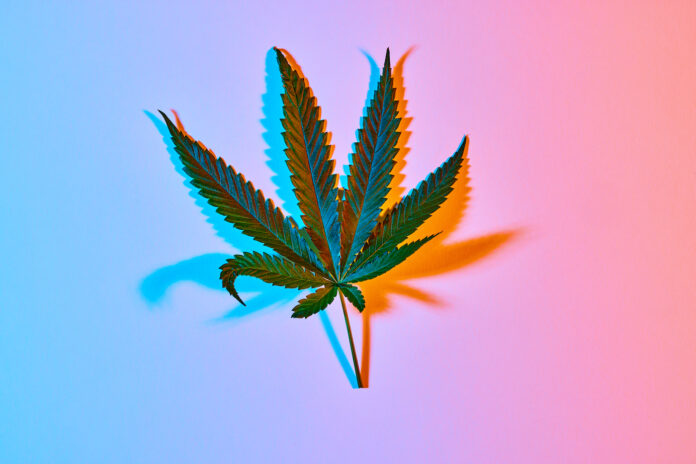While commercial cultivators are increasingly counting on high-tech sensors to monitor cannabis leaves and their surrounding environment, the human eye is far from obsolete. With a trained eye and a clear plan of action, anyone on the farm or home garden can identify a potential issue before it becomes a serious problem. From signs of a change in pH to subtle shifts in plant color or texture, these visual cues can be invaluable in identifying cannabis leaf symptoms and maintaining plant health.
We reached out to a handful of seasoned cultivators to provide expert tips for overcoming pH swings, measuring nutrients with electrical conductivity, and identifying early signs of common problems such as nutrient burn, light stress, and pest infestations.
Nutrient Burn
Nutrient burn is a common issue among new growers who mistakenly equate more food with a bigger yield. Cannabis leaves show signs of nutrient burn with brown spots at the edge, giving a “burnt” illusion that inspired the name. Below the soil, root rot can form if the plant can’t get rid of excess nutrients. With experienced growers, it’s more common when incorporating new products and amendments to dial in new strains. Generally speaking, cannabis cultivators should implement a new nutrient regimen at a lower dose than recommended to understand the product’s concentration, composition, and effect.
“Measure the electrical conductivity (EC) of your feeding solution and the drain-off water,” said Max Majot, technical manager and expert grower at Royal Queen Seeds. “If the EC is higher in the drain by more than 0.6, it means your plant is rejecting nutrients and already has too much.”
Jeff Gumaer, director of cultivation at Proper Cannabis, monitors EC levels at Proper Cannabis to ensure plants are metabolizing nutritional amendments effectively.
“We monitor EC levels in and out to prevent this [nutrient burn] from happening,” said Gumaer. “Certain strains may be prone to micronutrient deficiencies more than others. A lot of times, those deficiencies correct themselves as long as you’re keeping a close eye on the inputs and outputs of your feed.”
Underwatering and Overwatering
While watering sounds like the most fundamental part of growing a plant, it’s a struggle to perfect for growers of all skill levels. That’s why many professional cultivators turn to substrate sensors to let them know when to water plants throughout their life cycle. Without sensors, you can scratch the surface of the dirt with a finger, going about one-quarter of an inch into the soil to see if it’s still moist.
“Generally, the most skilled cultivator is the one responsible for watering amount and frequency as this plays a major role in plant health,” said Danny Murr-Sloat, founder at AlpinStash Genetics & Consulting. “Underwatering can cause nutrients to become ‘trapped’ in the grow media and thus unavailable for uptake—this can also cause wild pH swings. Most media is difficult to rehydrate once it dries out and this can cause issues throughout the growth cycle.”
When growing in pots, it’s easy to determine whether roots are dry by the weight of the pot.
“The most accurate way is to feel how heavy your pots are when watered versus dry,” said Majot. “According to this weight difference, you should be able to judge if it needs to be watered or not. Understanding this balance comes with experience and repeated handling.”
However, watering schedules change depending on the plant’s stage. When propagating and rooting new clones, it’s important to encourage the roots to form and reach for water with only a few irrigation events.
“Once healthy roots have formed and they are transplanted into their next home in the vegetative state, we make sure that the plants are eating the fertilizer that we give them and are ‘fat, healthy, and happy,’” said Gumaer. “When we change the photoperiod to initiate them into flower—typically 12 hours on, 12 hours off—we will look to let plants dry back to a certain percentage of moisture to manage the ‘stretch’ and internodal spacing.”
Nutrient Deficiencies
A nutrient deficiency can be just as harmful as a nutrient burn, and there are quite a few ways a cannabis plant might be affected. Whether it’s a nitrogen deficiency, calcium deficiency, potassium bicarbonate deficiency, or manganese deficiency, cannabis leaves will show you what they’re missing.
“Nutrient deficiencies are less common than most people think and are often caused by environmental issues [underwatering, root zone too cold, etc.] or improper media pH rather than an actual lack of nutrients in the feed,” said Murr-Sloat.
Before addressing any potential nutrient deficiency, Majot recommends keeping a close eye on the water.
“The pH of your watering solution will vary at every stage and is important to get right to ensure the complete assimilation of the necessary nutrients,” said Majot. “Be mindful of the dosage and recommendation of your nutrient provider.”
Are leaves starting to turn yellow and curl? Boost the potassium feed. A calcium deficiency will appear as small brown spots circled with dark green, stunted growth, or distorted leaves. Manganese deficiencies show as yellowed leaves that will turn mottled brown, and nitrogen-deficient leaves will claw downward and turn a darker shade of green.
According to Gumaer, the first step to addressing a potential nutrient deficiency is to ensure plants can metabolize their total EC.
“Having a finger on the pulse of your plants’ metabolism, whether using salts and an inert media or a buffered media with other amendments, is important,” he added.
Light Burn
Indoor plants always run the risk of light burn with high temperatures, especially among new growers who aren’t taking the proper measurements or making the right adjustments as their plants grow. It typically occurs when a plant is exposed to excessive light intensity, either because the plant isn’t accustomed to such levels or isn’t healthy enough to handle the increased photosynthetic photon flux density.
“If you don’t have tools to measure the flux of light, you should observe the distance between the fixture and the canopy recommended by the light supplier,” said Majot. “The first sign of excessive light is usually that the leaves on the top canopy will start curling outward, then yellowing and browning will follow, and finally the leaves will dry out and crackle.”
Overexposure to light and high levels of heat will cause leaves to turn yellow and eventually burn. Dimming the lights is a fast and effective way to preserve top colas in tight spaces and avoid heat stress.
“At higher light intensities, everything about the plant’s health has to be on point,” added Murr-Sloat. “Check the temperature of hotspots to ensure that what you are seeing is caused by the light intensity and not a hot pocket.”
Improper pH Balance
The pH of local water supplies can change every week, that’s why it’s important to buy a pH testing device or kit to monitor and adjust the pH of a water solution. Without the right pH range, plants can’t absorb the nutrients required to grow and thrive, leading to a nutrient lockout.
“For pH adjustment, buy a testing device or kit and adjust the pH of your watering solution,” said Majot. “Correct pH levels are essential for optimal uptake, otherwise, it creates a ‘lock out’ for the plant and nutrient deficiency.”
Unfortunately, visual plant signs are a poor indicator of pH balance, which is why growers should regularly use testing strips, liquid test kits, and pH meters to ensure accurate results before feeding plants.
“Depending on the fertilizer you are using, the pH range that you typically look for [fertilizer in and run-off] is between 5.5 and 6.3,” said Gumaer. “Water source pH varies from region to region, so understanding where you are starting is important.”
Powdery Mildew
White powdery mildew (PM) is another common marijuana leaf problem. Indoor cultivators can expect to encounter this type of fungi with high humidity levels accompanied by a lack of adequate airflow in the grow room. Combatting this issue starts with a deep clean before each new grow. Ensure a spore-free space with bleach, hydrogen peroxide, and dedicated disinfection products.
“The main cause of sporulation/powdery mildew outbreak is temperature swings from light to dark—10 degrees plus—and a dew point spike when the temps drop [at night],” said Gumaer. “Managing your environment and dialing in your irrigation schedule will help prevent the PM nightmare.”
While humidity plays the biggest role, some strains just perform better in different conditions.
“There are PM strains that thrive in high humidity and low humidity, so controlling the humidity isn’t always the answer,” said Murr-Sloat. “Seek out cultivars that are naturally resistant to PM.”
Cultivators may want to avoid clones and stick with seeds in parts of the country where mildew and mold tend to thrive.
According to Ben Lind, co-founder and chief science officer at Humboldt Seed Company, strain selection and preventative maintenance are essential to pair in these environments.
“While clones have their advantages, PM can spread from clones, which is a big benefit of growing cannabis seeds in some climates,” said Lind. “With regular pruning to ensure proper airflow, strains like California Octane that were crossed from two PM-resistant parents in Dream Queen and Papaya can help growers stack the odds in the right direction when dealing with difficult climates.”
With any cultivar, leafing, skirting, and lollipopping can go a long way to improve airflow and reduce the chance of a PM infection.
Pests
Pests are a regular problem for all kinds of plants, especially aromatic ones like cannabis. Cultivators must battle aphids feeding on plant juices, predatory mites gorging on the chlorophyll of leaves, and unwanted insects that can leave “sooty mold” — a black mold produced from bugs that excrete sticky honeydew.
No matter who you ask, everyone recommends creating a preventative pest management plan to avoid a sick cannabis plant. Typically, this includes many options for dealing with affected plants with OMRI-certified pesticides and biological controls. Predatory insects are a good way to fight pests without the use of pesticides. In fact, adult ladybugs can eat 100 spider mites a day, making them a popular solution for many farms.
“Proper identification is always the key in effectively fighting and managing pests,” said Murr-Sloat. “Research and understand integrated pest management and its five-step approach to pest and disease management. This is the standard in all of horticulture and agriculture for a reason.”
Five-Step Approach to Integrated Pest Management
- Identification: Identify the pest by comparing images with commonly known bugs.
- Monitoring: Determine the scale of the problem by monitoring over time.
- Follow control-action guidelines: Decide the proper moment to take action based on the scale of the problem to avoid unnecessary intervention.
- Control: Prioritize non-chemical control methods first to minimize risk to non-target organisms.
- Evaluation: Evaluate the effectiveness of your actions and adjust standard operating procedures accordingly.










[…] AI can help identify how efficient the crop steering is. By monitoring data such as plant height, leaf surface temperatures, and the difference between air and leaf temperature, cultivators easily can see how […]
[…] not able to uptake nutrients from the growing medium. Having a pH that is out of range will cause leaves to start yellowing and show signs of deficiencies. If the pH is not corrected, necrosis and death of the plant tissue […]
[…] fight against fungi and pests is a war with no end in sight. Whether it’s aphids, spider mites, fungus, gnats, or mealybugs, there’s always something trying to devour a farmer’s profits for […]
[…] which strains perform best, looking for plants that are free of diseases and resistant to drought, pests, and pathogens—no easy feat with so many viruses infecting grows from coast to coast. The process […]
[…] eyes on your plants on a daily basis,” Vaserling said. “Thankfully, bud rot is not like a powdery mildew that spreads. It’s very specific to that individual bud. As long as you cut it out and secure […]
[…] effects, medical benefits, and overall retail prices for cultivators and brands. Recognizing major leaf problems is something everyone around the garden should know how to […]